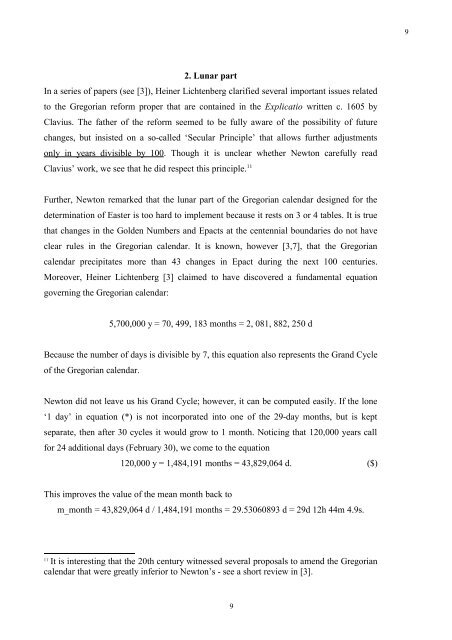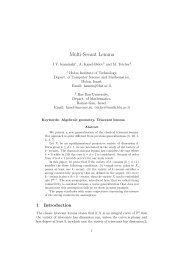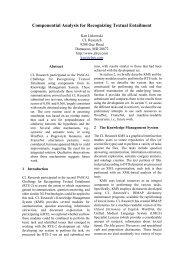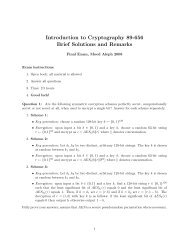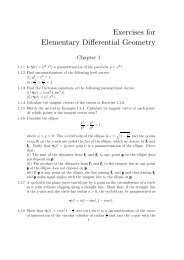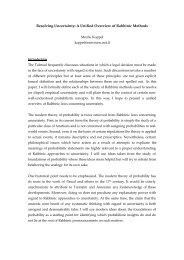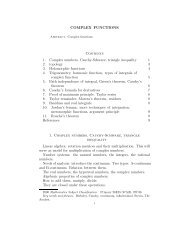Reform of the Julian Calendar as Envisioned by Isaac Newton
Reform of the Julian Calendar as Envisioned by Isaac Newton
Reform of the Julian Calendar as Envisioned by Isaac Newton
Create successful ePaper yourself
Turn your PDF publications into a flip-book with our unique Google optimized e-Paper software.
9<br />
2. Lunar part<br />
In a series <strong>of</strong> papers (see [3]), Heiner Lichtenberg clarified several important issues related<br />
to <strong>the</strong> Gregorian reform proper that are contained in <strong>the</strong> Explicatio written c. 1605 <strong>by</strong><br />
Clavius. The fa<strong>the</strong>r <strong>of</strong> <strong>the</strong> reform seemed to be fully aware <strong>of</strong> <strong>the</strong> possibility <strong>of</strong> future<br />
changes, but insisted on a so-called ‘Secular Principle’ that allows fur<strong>the</strong>r adjustments<br />
only in years divisible <strong>by</strong> 100. Though it is unclear whe<strong>the</strong>r <strong>Newton</strong> carefully read<br />
Clavius’ work, we see that he did respect this principle. 11<br />
Fur<strong>the</strong>r, <strong>Newton</strong> remarked that <strong>the</strong> lunar part <strong>of</strong> <strong>the</strong> Gregorian calendar designed for <strong>the</strong><br />
determination <strong>of</strong> E<strong>as</strong>ter is too hard to implement because it rests on 3 or 4 tables. It is true<br />
that changes in <strong>the</strong> Golden Numbers and Epacts at <strong>the</strong> centennial boundaries do not have<br />
clear rules in <strong>the</strong> Gregorian calendar. It is known, however [3,7], that <strong>the</strong> Gregorian<br />
calendar precipitates more than 43 changes in Epact during <strong>the</strong> next 100 centuries.<br />
Moreover, Heiner Lichtenberg [3] claimed to have discovered a fundamental equation<br />
governing <strong>the</strong> Gregorian calendar:<br />
5,700,000 y = 70, 499, 183 months = 2, 081, 882, 250 d<br />
Because <strong>the</strong> number <strong>of</strong> days is divisible <strong>by</strong> 7, this equation also represents <strong>the</strong> Grand Cycle<br />
<strong>of</strong> <strong>the</strong> Gregorian calendar.<br />
<strong>Newton</strong> did not leave us his Grand Cycle; however, it can be computed e<strong>as</strong>ily. If <strong>the</strong> lone<br />
‘1 day’ in equation (*) is not incorporated into one <strong>of</strong> <strong>the</strong> 29-day months, but is kept<br />
separate, <strong>the</strong>n after 30 cycles it would grow to 1 month. Noticing that 120,000 years call<br />
for 24 additional days (February 30), we come to <strong>the</strong> equation<br />
120,000 y = 1,484,191 months = 43,829,064 d. ($)<br />
This improves <strong>the</strong> value <strong>of</strong> <strong>the</strong> mean month back to<br />
m_month = 43,829,064 d / 1,484,191 months = 29.53060893 d = 29d 12h 44m 4.9s.<br />
11<br />
It is interesting that <strong>the</strong> 20th century witnessed several proposals to amend <strong>the</strong> Gregorian<br />
calendar that were greatly inferior to <strong>Newton</strong>’s - see a short review in [3].<br />
9


